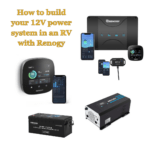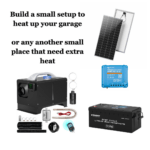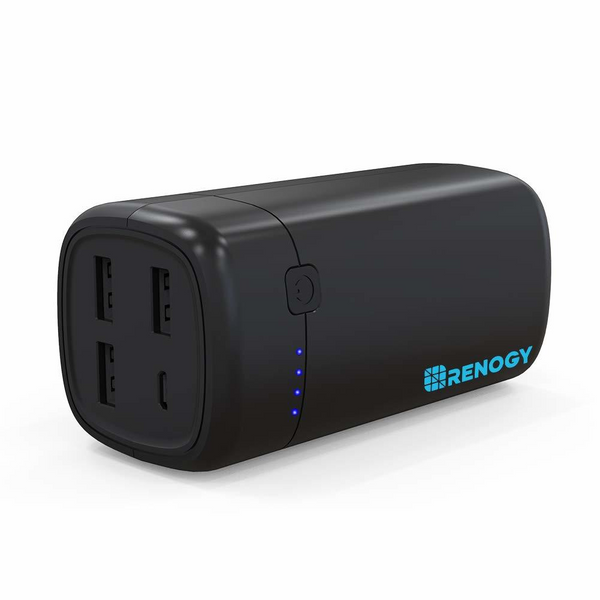
How to build your 12V power system in an RV with Renogy
How to build your 12V power system in an RV
The energy loss in an inverter can be influenced by several factors, regardless of whether it’s a small inverter or a big inverter. The efficiency of an inverter is a critical aspect that determines how much energy is lost during the conversion process from DC to AC power. Energy loss in inverters is primarily due to resistive losses, switching losses, and other internal losses within the components.
1. Resistive Losses: Resistive losses occur when current flows through the internal wiring, semiconductor materials, and other components of the inverter. These losses are typically proportional to the square of the current passing through the components. Larger inverters designed to handle higher power capacities may have larger and thicker internal components, which can help reduce resistive losses compared to smaller inverters with smaller and thinner components.
2. Switching Losses: Switching losses are incurred during the transition of the semiconductor devices (transistors or IGBTs) from the on-state to the off-state and vice versa. Larger inverters generally use more robust and efficient semiconductor devices, allowing for reduced switching losses compared to smaller inverters using less advanced components.
3. Heat Dissipation: Larger inverters often have better heat dissipation capabilities due to larger heat sinks and cooling systems. Effective heat dissipation is crucial for reducing energy losses, as excess heat can further decrease the efficiency of the inverter. Smaller inverters may face challenges in heat dissipation, leading to higher energy losses when operating at high power outputs.
4. Standby Power Consumption: Inverters often consume a small amount of power even when no load is connected (standby power). Larger inverters may have slightly higher standby power consumption due to the presence of additional circuitry and features. However, the difference in standby power consumption between small and large inverters is generally negligible compared to their overall efficiency.
It’s important to note that the efficiency of both small and large inverters has improved significantly in recent years due to advancements in technology and manufacturing processes. High-quality inverters, regardless of size, can achieve efficiency levels of 90% or higher.
When choosing an inverter, it’s essential to consider the manufacturer’s stated efficiency ratings and select a model with a high efficiency to minimize energy losses.
Overall, while there might be some variations in energy loss between small and large inverters, the difference is not significant when comparing modern, well-designed inverters from reputable manufacturers.
The key factor is to choose an inverter with high efficiency, suitable for your specific application and power requirements, to ensure optimal performance and minimize energy losses.
An inverter is an electronic device that converts direct current (DC) electricity into alternating current (AC) electricity. It is commonly used in solar power systems, battery backup systems, RVs, boats, and other applications where AC power is needed but only DC power is available. The primary function of an inverter is to enable the use of household appliances and electronic devices that require AC power from a DC source, such as solar panels or batteries.
The basic operation of an inverter involves several key stages:
Rectification: If the inverter is connected to a DC power source like a battery or solar panel, the first step is to convert the DC power into a stable DC voltage. This is achieved using a rectifier or a set of electronic switches.
Oscillator and Control Circuit: The inverter has an oscillator and control circuit that generates a high-frequency AC signal. The frequency of this signal is typically in the range of tens of kilohertz to several megahertz.
Modulation: The DC voltage is then modulated by the high-frequency AC signal. This modulation process controls the width and timing of the AC signal and is usually achieved through pulse-width modulation (PWM) techniques.
Output Filtering: The modulated AC signal is passed through output filters to smooth out the waveform and reduce harmonic distortion, ensuring a more sinusoidal AC output.
Output Stage: Finally, the filtered and modulated AC signal is amplified and sent to the output terminals of the inverter to power various electrical devices.
When purchasing an inverter, several factors should be taken into account to ensure it meets your specific needs and provides reliable performance. Here are some essential considerations:
Power Rating: Determine the power rating or capacity of the inverter you require, usually expressed in watts (W) or kilowatts (kW). The inverter’s capacity should match or exceed the total power consumption of the appliances and devices you plan to connect.
Waveform Type: Inverters can produce pure sine wave, modified sine wave, or square wave output. Pure sine wave inverters provide clean and stable AC power, suitable for all types of appliances, while modified or square wave inverters may be less compatible with certain sensitive electronics.
Application: Consider the intended application of the inverter, such as off-grid solar systems, grid-tie systems, RVs, boats, or emergency backup power. Different applications may require specific features or functionalities.
Efficiency: Look for inverters with high efficiency ratings, as they convert DC power into AC power more effectively, reducing energy losses.
Voltage Compatibility: Ensure the inverter’s input and output voltage specifications are compatible with your power source (e.g., batteries or solar panels) and the voltage requirements of your appliances.
Safety Features: Check for built-in safety features such as overload protection, short-circuit protection, and temperature regulation to safeguard the inverter and connected devices.
Monitoring and Communication: Some inverters come with monitoring capabilities and communication interfaces, allowing you to track performance and receive real-time data on your power system.
Brand and Warranty: Choose reputable brands known for their reliability and customer support. Also, check the warranty duration and terms to ensure peace of mind.
Installation and Mounting: Consider the installation requirements and mounting options of the inverter, especially if you have limited space or specific installation constraints.
These inverters are commonly referred to as “inverter chargers” or “hybrid inverters” as they combine the functionality of both an inverter and a battery charger. These devices are particularly useful in off-grid or hybrid solar power systems, where they can convert DC power from batteries to AC power for use in household appliances and also charge the batteries from an AC power source or a solar panel array. Some popular brands that offer inverter chargers similar to Renogy’s offerings include:
AIMS Power: AIMS Power is known for its wide range of power conversion products, including inverter chargers suitable for various applications like off-grid and RV setups.
Go Power!: Go Power! produces inverter chargers designed for mobile applications such as RVs, boats, and work trucks, offering both pure sine wave and modified sine wave options.
Victron Energy: Victron Energy is a well-respected brand known for its high-quality energy products, including inverter chargers suitable for off-grid and hybrid systems.
Magnum Energy: Magnum Energy offers a range of inverter chargers with different power capacities, making them suitable for both residential and commercial applications.
OutBack Power: OutBack Power manufactures hybrid inverter chargers designed for off-grid and grid-tie applications, often used in conjunction with solar and battery systems.
SMA Solar Technology: SMA also offers inverter chargers with battery backup functionality, allowing homeowners to use stored solar energy during grid outages.
These are just a few examples, and many other reputable brands provide inverter chargers with various features and specifications. When considering an inverter charger from any brand, it’s essential to evaluate factors such as power capacity, efficiency, battery compatibility, surge capability, and additional features like monitoring and remote control options. Additionally, keep in mind that the availability of specific models and features may vary depending on your region and the current market offerings. Therefore, it’s recommended to research and compare different brands and models to find the inverter charger that best suits your specific energy needs and requirements.
How do I install a Renogy inverter?
What type of batteries are compatible with Renogy inverters?
Can I use a Renogy inverter in a mobile/RV setup?
Why is my Renogy inverter not turning on?
How can I troubleshoot low power output from my Renogy inverter?
What is the difference between a pure sine wave and a modified sine wave inverter?
Can I connect multiple inverters in parallel for increased power output?
Use Renogy inverter when you have a battery that is stationery and is installed properly and use a solar generator when you want power that is portable. Make sure that you select an inverter that is big enough for the things you wish to connect to the inverter.
If you want to get an estimated number of what your device takes then use my sheet here
Renogy Inverter comes with different sizes and functions, select the one that suits you best and read more on Renogy website










How to build your 12V power system in an RV

Why the Renogy REGO 3000W Inverter Charger is Your Ultimate

REGO 12V 3000W Pure Sine Wave Inverter Charger Combines both

How to build a small setup to heat up your

Renogy 400W Portable solar panel Introducing Renogy’s Cutting-Edge Portable Solar

Renogy ONE Core Elevating Your RV Experience with Smart Power

Renogy 12V 200Ah Smart battery Perfect for your RV or

Renogy combines the inverter and battery charger If you’re an

Gather and monitor information from all of your connected devices

Get all the power you need off grid with Renogy

Renogy Premium Solar Kits Renogy 12V Premium Solar Kit: Powering

Renogy DC On-Board Charger with MPPT Gel, AGM, and Lithium
 | 20000mAh Power Bank World's Smallest USB Phone Battery Charger - $39.99 Featuring silk-like texture, rounded edges, and the same high-density battery cells built in a Model X, Renogy 20000mAh portable charger is the epitome of understated style and advanced charging technology. |
 | 10000mAh Power Bank World's Smallest & Lightest USB Phone Battery Charger - $20.99 Renogy pushes limits further to make one of the smallest and lightest 10000mAh external battery of its kind. High in capacity and uncompromised in quality, this ultra-compact mini power bank juices up your devices fast and lasts long.Whether you are commuting on the subway or strolling along boulevards, this slim yet reliable power charger always has your back. |

Get more power outdoors with EcoFlow SMART Generator 4000 EcoFlow Smart Generator 4000 (Dual Fuel) – The Ultimate Power Solution EcoFlow Smart Generator 4000 (Dual

EcoFlow DELTA 3 Power Station with the fastest charging speed DELTA 3 Series Portable Power Station | EcoFlow US | EcoFlow The EcoFlow Delta 3

EcoFlow RIVER 3 Portable Power Station EcoFlow River 3: The Ultimate Portable Power Station for Outdoor Adventures If you love camping, road trips, or spending

Winnerwell Flatfold Fire Pit The Ultimate Portable Campfire The Ultimate Portable Campfire: Benefits of the Winnerwell Flatfold Fire Pit If you’re an outdoor enthusiast, the

ZERO BREEZE Mark 3 Beating the Heat and Save Your Summer ZERO BREEZE Mark 3 is the latest cool product of the portable air conditioner

Camplux outdoor hot water shower for your best convenience The Ultimate Comfort: Why You Should Bring a Camplux Portable Shower on Your Outdoor Adventures When